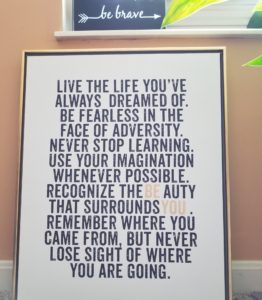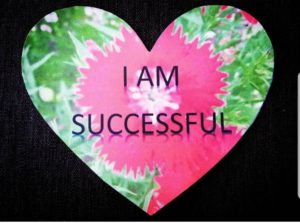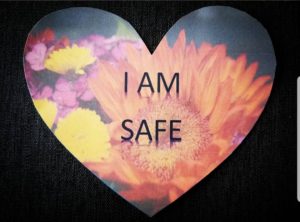
Our daughter has been on a tweenage metamorphosis of late. Some days she’s clad in nothing but boys’ Nike attire and others she is lounging poolside in her cute little bikini sporting her Ray-Ban-esque Dollar Store knock-off shades. As she wriggles her way toward thirteen, a re-decorating of her cocoon was obviously in order. Out with the puppy calendar, pastel-colored name letters, and all things fru-fru-ish. In with a basketball comforter, tree lights strung about her walls, fresh white paint on the once-pink mirror, and a huge Nike swoosh hung proudly (next to the giant teddy bear . . . some things are a must keep no matter how grown up you think you are).
I was fortunate enough to inherit some inspirational decor in the process: “Live the life you’ve always dreamed of. Be fearless in the face of adversity. Never stop learning. Use your imagination whenever possible. Recognize the BEauty that surrounds YOU. Remember where you came from, but never lose sight of where you are going.”
Yes. So much yes.
I spoke to my mom this morning. About twenty-three times. Okay, only about seven, but still. She was drunk and depressed. I have avoided that combo since my childhood. She babbled on about my dad visiting her (scary thought considering he’s been deceased for nine years), wearing a winter coat all night because she couldn’t sleep, how my sister Katie was coming over to take Katie to lunch for Katie’s birthday (I’m still trying to figure that one out), hugging her new picture book and crying, asking me to call the Bureau of Motor Vehicles about my nephew’s car, needing me to call back and wake her up because she was still sleeping (um, no, Mom, you are awake and talking to me right now), and arguing with her dead friends.
You are right to tell me I should put her in a nursing home, have her declared incompetent of self-care. After all, I found out she had attempted to walk to the liquor store at eighty-two years old because she ran out of vodka. In eighty-something degree heat. But, she hitched a ride halfway there (insert eye-roll here).
However, in a day or two, my phone will ring and my bright and cheery mom will start in with her sober chatter, “Hi, TT! How’s my beautiful daughter today? If you have time, will you stop by and show me how to use this new vacuum you bought me? And pick me up some cranberry juice on your way. Did I tell you about the meal I’m planning for my party tonight?” And I’ll hear all about her social events for the next week . . . dinner parties with gourmet foods all cooked by her, movie nights with her old lady friends, rosary group, and noon mass at St. Rose. Sober and coherent and oh-so-self-sufficient.
Leaving me and my sister in that limbo land. Damned if we do and damned if we don’t. A pendulum existence between she-is-going-to-kill-herself-with-booze-and-pills and why-the-hell-did-you-stick-your-obviously-fun-and-perky-mom-in-a-nursing-home?
So, here I sit. Contemplating my new office decor.
“Live the life you’ve always dreamed of.”
Is it my duty to spend my days scurrying about making sure sober Mom is nurtured and drunk Mom lives? The life I’ve dreamed of certainly does not include either.
“Be fearless in the face of adversity.”
Why is it easier to face my own demons and confront my fears than it is to make a decision about where my mom should live? Perhaps because it’s HER life and not mine. This should be my mom’s decision, yet the only choice she is making is the one that’s haunted me since my teen years, when she told the family therapist, “If you are asking me to choose between alcohol and my family, I choose vodka.”
“Never stop learning.”
Joining Al-Anon was not so much eye-opening as it was a spotlight into my soul. Listening to others speak my thoughts, cry my tears, and confess to my lifelong fantasy of walking away from the chaos wreaked by my addict mother. Learning to end my co-dependent relationship with my mother has left me feeling more battered than the days she’d scream for my dad to hit me. How do I let go of my deeply ingrained Catholic guilt? Is there a way to let an old drunk hit rock bottom without shouldering the fallout? Who else will be there to clean it all up? (asks the over-achieving peace-keeper in me)
“Use your imagination whenever possible.”
I have imagined chunks of my life away. Sometime I wonder how much time I squandered day-dreaming my escapes. As a kid, my sister and I would lie awake in her rainbow-comforter-clad waterbed, dreaming up our lottery-winning adventures. We would buy our parents the white house with the blue roof near Grandma and Grandpa’s place in Covington. Then we would buy a camper and never look back. Today I dream of living my island life with no desire to look back at the chaos of addiction. Is that an acceptable use of imagination?
“Recognize the BEauty that surrounds YOU.”
Be. You. In gold letters.
Be.
You.
I spend every day noticing something beautiful in my life. From sunsets to ladybugs (I noticed both of those today!) to peaceful moments after the babbling phone calls.
Is there beauty to be found in her nonsense? Perhaps by being me, in all of my glitter-shitter glory, I can recognize the beauty that is my mom’s lesson. She has taught me to appreciate the moments between the mayhem. In all honesty, she’s taught me to appreciate the blessings within the torment, as well.
“Remember where you came from, but never lose sight of where you are going.”
I look like her. Especially as I age. I act like her, too. That’s mostly a good thing. She’s kind-hearted, likes to throw parties, loves to laugh, has deep faith, appreciates the value of friendship, and cries over sappy birthday cards and the Budweiser dog commercials. Yep. I’m my mom. In so many ways.
However . . . I really hate vodka.




















